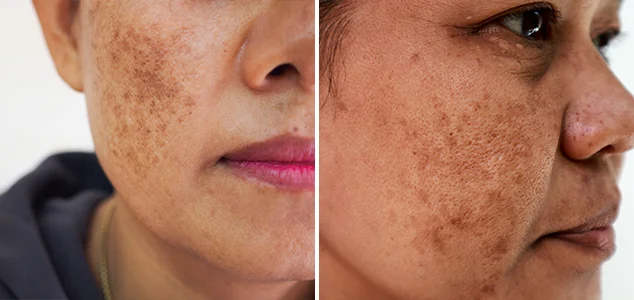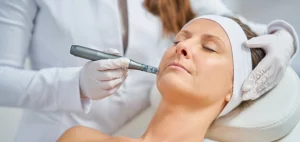Melasma and hyperpigmentation look alike, confusing many people. But they’re different in their causes, how they look, and their treatment.
Melasma usually shows up as brown patches on the face, caused by hormones, sunlight, or family traits. Hyperpigmentation is when there are dark spots on the skin, from things like acne marks, swelling, or too much sun. It’s important to know these differences so we can treat them right.
Today’s blog will explain melasma vs hyperpigmentation, and explore ideas on how to achieve clear and even skin.
What is Melasma?
Melasma is a common skin condition characterized by symmetrical, brown to gray-brown patches on the face, especially on the cheeks, bridge of the nose, forehead, chin, and above the upper lip.
It is more prevalent in women and those with darker skin tones. Melasma is often triggered by hormonal changes, such as pregnancy or oral contraceptive use, and aggravated by sun exposure.
What is Hyperpigmentation
Hyperpigmentation refers to patches of skin that become darker than the surrounding areas due to excess melanin production. This condition can occur anywhere on the body, including the face, arms, and legs.
Common types include post-inflammatory hyperpigmentation (PIH) following skin inflammation or injury, solar lentigines (sun spots), and melasma.
Melasma vs Hyperpigmentation
Melasma is a specific type of hyperpigmentation characterized by brown to gray-brown patches on the face, often triggered by hormonal changes and sun exposure.
Hyperpigmentation, on the other hand, encompasses a broader range of darkening skin conditions caused by various factors such as inflammation, injury, or sun exposure, occurring on any part of the body.
What Are The Types?
Melasma and hyperpigmentation can manifest in various forms, each with its characteristics. Here are some common types:
– Melasma
- Epidermal Melasma: This type of melasma appears closer to the surface of the skin and often presents as brown patches. It is usually more responsive to treatment compared to other types.
- Dermal Melasma: Dermal melasma occurs deeper in the skin layers, appearing as bluish-gray patches. It can be more challenging to treat compared to epidermal melasma.
- Mixed Melasma: As the name suggests, mixed melasma involves a combination of both epidermal and dermal types, resulting in patches with varied colors and depths.
– Hyperpigmentation (HIP)
- Post-Inflammatory Hyperpigmentation (PIH): PIH occurs as a result of inflammation or injury to the skin, such as acne, eczema, or trauma. It presents as darkened patches at the site of the previous injury or inflammation.
- Sun-Induced Hyperpigmentation: Prolonged exposure to sunlight can trigger the overproduction of melanin, leading to the development of dark spots or patches on the skin, commonly on sun-exposed areas like the face, hands, and shoulders.
- Hormonal Hyperpigmentation: Hormonal fluctuations, particularly during pregnancy (melasma gravidarum or “pregnancy mask”) or due to oral contraceptive use, can lead to the development of hyperpigmentation.
- Drug-Induced Hyperpigmentation: Certain medications, such as some antibiotics, antimalarials, and chemotherapy drugs, can cause hyperpigmentation as a side effect.
- Genetic Hyperpigmentation: Some individuals may be genetically predisposed to developing hyperpigmentation, which can get worse by environmental factors like sun exposure.
What is The Best Treatment?
– Melasma Treatment
- Topical Depigmenting Agents: Such as hydroquinone, tretinoin, or corticosteroids.
- Chemical Peels: Help to lighten pigmentation.
- Laser Treatments: Target pigmented areas for improved skin tone.
– Hyperpigmentation Treatment
- Topical Treatments: Including retinoids, hydroquinone, or kojic acid.
- Chemical Peels: Exfoliate the skin to reduce pigmentation.
- Laser Therapy: Targets melanin to lighten dark spots.
Causes
Both melasma and hyperpigmentation can be caused by:
- Hormonal changes (pregnancy, birth control pills).
- Sun exposure.
- Inflammation or injury to the skin.
- Genetics.
How is it Treated?
Treatment for melasma and hyperpigmentation typically involves a multifaceted approach. For melasma, topical medications such as hydroquinone, tretinoin, and corticosteroids are commonly prescribed to lighten the skin. Similarly, hyperpigmentation treatment involves topical treatments containing ingredients like hydroquinone, kojic acid, azelaic acid, retinoids, and vitamin C to lighten dark patches.
Additionally, strict sun protection practices, including the use of sunscreen with a high SPF, wearing protective clothing, and minimizing sun exposure, are crucial to prevent worsening of melisma and hyperpigmentation. Various procedures like chemical peels, microdermabrasion, and laser therapy may also be employed to lighten melisma and hyperpigmentation patches.
Prevention
Preventive measures include:
- Sun Protection: Regular use of sunscreen with high SPF.
- Avoiding Hormonal Triggers: Using caution with hormonal therapies.
- Prompt Treatment of Skin Inflammation: To prevent post-inflammatory hyperpigmentation.
Diagnosis
Diagnosis of melasma and hyperpigmentation typically involves visual examination by a dermatologist, sometimes aided by Wood’s lamp or skin biopsy for confirmation.
Duration
Both conditions can be chronic and may require long-term management. Melasma can improve with treatment but may recur with sun exposure or hormonal changes.
Risk Factors
Risk factors include:
- Gender (more common in women).
- Darker skin tones.
- Hormonal changes.
- Sun exposure.
Common Triggers
Triggers include:
- Pregnancy or oral contraceptives (for melasma).
- Sun exposure.
- Skin inflammation or injury.
Typical Locations
Hyperpigmentation can occur anywhere on the body but is most commonly found in areas exposed to the sun, such as the face, neck, hands, and arms. Melasma specifically tends to appear on the face, particularly on the cheeks, forehead, upper lip, and chin. These areas are more prone to hormonal influences and sun exposure, which are primary triggers for melasma development.
Age Group
Hyperpigmentation can affect individuals of any age group, but it becomes more common with advancing age due to cumulative sun exposure and hormonal changes.
Melasma mainly affects women, especially those in their reproductive years, typically appearing between the ages of 20 and 50. However, it can also occur in men and older women, especially if there’s significant sun exposure or hormonal fluctuations.
Symptoms
Symptoms include:
- Dark patches or spots on the skin.
- Symmetrical appearance in the case of melasma.
- Variable sizes and shapes.
Melasma vs Hyperpigmentation Pictures
Melasma on Arms
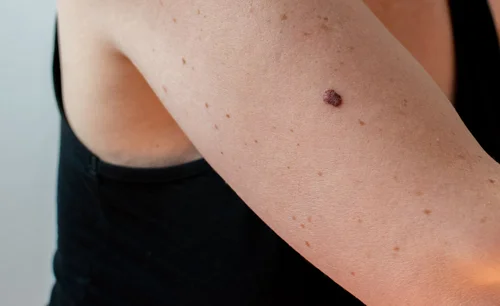
Melasma on Neck
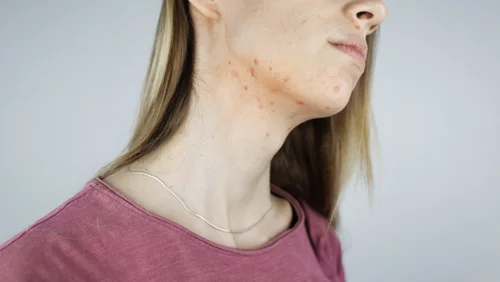
Hyperpigmentation on Forehead
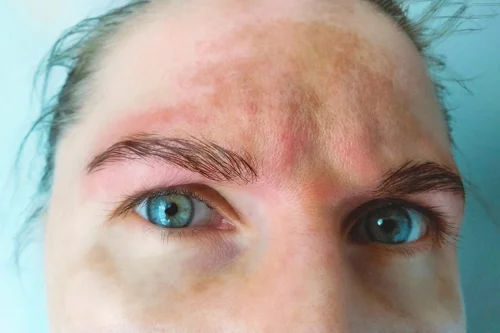
Hyperpigmentation on Arms
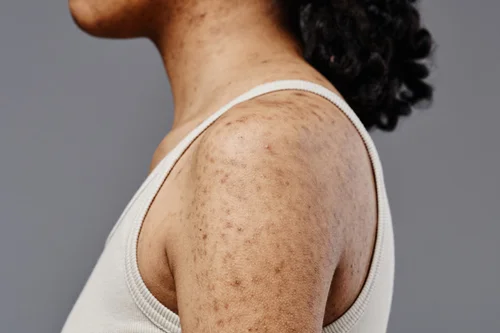
Melasma vs Sun Spots
Melasma is characterized by larger, often symmetrical patches related to hormonal changes, while sun spots (solar lentigines) are smaller, isolated spots caused by sun exposure.
Where Can You Find a Dermatologist in Manhattan, NYC?
For expert dermatological care related to melasma, hyperpigmentation, and other skin concerns in Manhattan, NYC – Syra Aesthetics offers comprehensive treatments and consultations. Their specialized approach can help individuals manage and improve the appearance of these skin conditions effectively.
Frequently Asked Questions
Q1: Is hyperpigmentation also called melasma?
Hyperpigmentation refers to dark patches on the skin, while melasma specifically involves symmetrical brown or gray-brown patches on the face.
Q2: How do I know if I have hyperpigmentation or melasma?
Consultation with a dermatologist can help differentiate between hyperpigmentation and melasma based on appearance and medical history.
Q3: What is the fastest way to cure melasma?
The fastest cure for melasma involves a combination of treatments like topical creams, chemical peels, and laser therapy, tailored to individual needs.
Q4: Does melasma ever fully go away?
Melasma can lighten with treatment but may not fully disappear; ongoing sun protection and maintenance treatments are often necessary.
Q5: What food is bad for melasma?
Foods high in estrogen like soy and dairy might exacerbate melasma; a balanced diet with antioxidants and sun protection is recommended.
Q6: What is the best cream to remove melasma?
Creams containing ingredients like hydroquinone, retinoids, or kojic acid, prescribed by a dermatologist, are commonly used for melasma treatment.

About The Author
Dr. Syra Hanif M.D.
Board Certified Primary Care Physician
Dr. Hanif is the Director of Aesthetic Medicine. She is a board-certified physician in Aesthetic Medicine who specializes in using non-surgical alternatives in order to enhance one's appearance through Botox and fillers.
Read More




